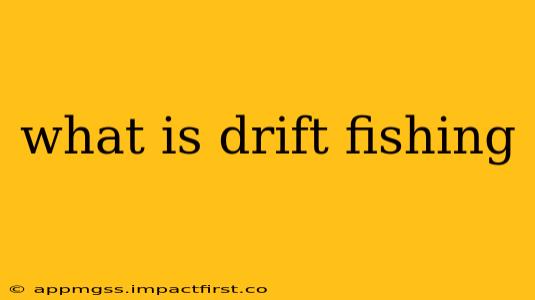Drift fishing is a captivating angling technique that involves letting your bait or lure drift naturally with the current or wind. Unlike actively reeling in a lure or casting repeatedly, drift fishing relies on the passive movement of the water to attract and entice fish. This makes it a relaxing yet effective method, particularly popular for targeting various species in diverse environments. Let's delve deeper into the intricacies of this rewarding fishing approach.
How Does Drift Fishing Work?
The core principle of drift fishing is simplicity itself: let your offering drift along with the natural flow of the water. This mimics the movement of natural prey, making it irresistible to hungry fish. Whether it's a slow, meandering drift in a calm river or a faster pace alongside a rocky coastline, the subtle motion often proves far more attractive than static bait. Your role involves managing the line, detecting bites, and setting the hook at the opportune moment. The success of drift fishing often hinges on understanding the underwater terrain and currents.
What Kind of Fish Can You Catch Drift Fishing?
Drift fishing's versatility is one of its significant strengths. The type of fish you'll encounter largely depends on your location and the type of bait or lure you use. Popular targets include:
- Salmon: Drift fishing is a highly effective method for targeting salmon in rivers and coastal areas.
- Trout: Many trout species are readily caught using drift fishing techniques in rivers and streams.
- Bass: Largemouth and smallmouth bass are often susceptible to drifting lures, particularly in lakes and slower-moving rivers.
- Catfish: Drifting bottom baits can be incredibly successful in attracting catfish.
- Panfish: Sunfish, crappie, and bluegill are all potential catches when drift fishing with smaller baits.
What Gear Do You Need for Drift Fishing?
The essential gear for drift fishing is generally quite straightforward:
- Rod and Reel: A medium-to-medium-heavy rod with a smooth-spinning reel is ideal for most drift fishing situations.
- Line: The line weight depends on the target species and conditions; monofilament or braided line are common choices.
- Bait or Lures: This is highly variable, ranging from live bait like worms and minnows to artificial lures such as spoons, spinners, and jigs.
- Weights: Sinker weights help control the drift and depth of your bait or lure. The weight needed depends on current speed and desired depth.
- Bobbers (Floats): Bobbers are excellent for keeping your bait at a specific depth and indicating bites.
What are the Different Types of Drift Fishing?
While the core concept remains consistent, drift fishing can encompass several variations depending on location and technique:
- Downstream Drifting: This involves letting your bait drift naturally downstream with the current.
- Upstream Drifting: This more challenging technique requires precise control to keep your bait drifting upstream against the current.
- Coastal Drift Fishing: Often involves drifting along the shoreline, utilizing natural currents to present your bait or lure.
- Boat Drift Fishing: Drifting from a boat offers greater mobility and access to deeper water.
What are Some Tips for Successful Drift Fishing?
Mastering drift fishing involves understanding several key aspects:
- Reading the Water: Pay close attention to the current, depth, and underwater structure to determine the best drift path.
- Bait Selection: Choose bait or lures that are appropriate for the target species and water conditions.
- Line Management: Maintain a taut line to feel subtle bites and set the hook effectively.
- Patience: Drift fishing often requires patience; it's a relaxing technique, but success hinges on perseverance.
Is Drift Fishing Difficult to Learn?
Drift fishing is relatively easy to learn, especially for beginners. The basic technique is simple, and mastering it comes down to practice and observation. However, the effectiveness of drift fishing is enhanced through understanding water currents, fish behavior, and choosing the right gear.
Where Can I Go Drift Fishing?
Opportunities for drift fishing are abundant. Rivers, lakes, streams, and coastal areas all present viable locations. Research local fishing regulations and identify spots known for your target species. Local fishing guides and forums can offer invaluable insights into prime drift fishing spots.
This comprehensive guide should equip you with the knowledge to embark on your drift fishing adventures. Remember, patience, observation, and understanding the environment are key to success. Tight lines!
